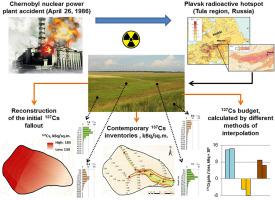Journal of Environmental Radioactivity ( IF 2.3 ) Pub Date : 2020-09-07 , DOI: 10.1016/j.jenvrad.2020.106386 Andrey P Zhidkin 1 , Evgeniya N Shamshurina 2 , Valentin N Golosov 3 , Mikhail A Komissarov 4 , Nadezhda N Ivanova 2 , Maxim M Ivanov 5

|
A detailed study of 137Cs redistribution was conducted within a small agricultural catchment in the highly contaminated Plavsk radioactive hotspot in the Tula region of Central Russia, 32 years after the Chernobyl nuclear power plant (NPP) accident, which occurred on April 26, 1986. Although more than three decades have passed since the Chernobyl NPP incident, 137Cs contamination is high. The 137Cs inventory varies from 67 to 306 kBq·m−2, which is 2–6 times higher than the radiation safety standard; however, the soils remain suitable for crop cultivation. The initial 137Cs fallout within the Plavsk radioactive hotspot was extremely heterogeneous, with a trend of decreasing 137Cs inventories from the NW to the SE directions within the studied territory. Contemporary 137Cs inventories are also very heterogeneous in the studied catchment. However, the trend of the initial 137Cs fallout does not appear in the contemporary 137Cs inventories on the slopes. Two methods of interpolation (expert-visual and automatic) were used to calculate the 137Cs budget, revealing high similarity in their 137Cs loss estimates; however, a large discrepancy was observed in their 137Cs gain estimates. A detailed analysis of 137Cs redistribution revealed the importance of hollows and “plow ramparts” (positive topographic forms on the boundaries of cultivated fields) in the transport and deposition of sediments. A quarter of the total 137Cs gain was deposited within the arable land, whereas a quarter was deposited within the non-plowing sides of the dry valley; the other half was deposited in the valley bottom. About 7–8 × 106 kBq of the 137Cs inventory flowed out of the catchment area, which was only about 2% of the 137Cs fallout after the Chernobyl NPP accident. About 89% of the total 137Cs reserve is concentrated in the top (0–25 cm) layer of soils, regardless of land use or location within the catchment.
中文翻译:

切尔诺贝利后期Cs-137在小农业流域(俄罗斯图拉地区)的土壤中重新分布的详细研究。
在1986年4月26日切尔诺贝利核电站(NPP)事故发生32年后,在俄罗斯中部图拉地区污染严重的Plavsk放射性热点的一个小型农业流域内,对137 Cs的重新分布进行了详细研究。尽管切尔诺贝利核电站事故已经过去了三十多年,但137 Cs的污染仍然很高。的137个Cs的库存从67到306 KBQ·米变化-2,比辐射安全标准2-6倍; 但是,土壤仍然适合农作物种植。Plavsk放射性热点内最初的137 Cs沉降非常不均匀,趋势是减少137 Cs在研究区域内,从西北到东南方向的CS清单。在所研究的流域,当代137 Cs清单也非常不同。但是,最初的137 Cs沉降的趋势并未出现在斜坡上的当代137 Cs清单中。两种插值方法(专家视觉和自动插值法)用于计算137 Cs预算,这显示了137 Cs损失估算的高度相似性。然而,在他们的137 Cs增益估计中观察到很大的差异。137详细分析Cs的重新分布揭示了凹陷和“犁壁垒”(耕地边界上的正形地形)在沉积物的运输和沉积中的重要性。在137 Cs的总收益中,有四分之一沉积在耕地内,而四分之一则沉积在旱谷的非耕作侧。另一半沉积在山谷底部。137 Cs存量中约有7–8×10 6 kBq流出集水区,这仅是切尔诺贝利核电厂事故后137 Cs沉降的2%。不论土地用途或流域内的位置如何,总137 Cs储量中约有89%集中在土壤的顶层(0–25 cm)。



























 京公网安备 11010802027423号
京公网安备 11010802027423号